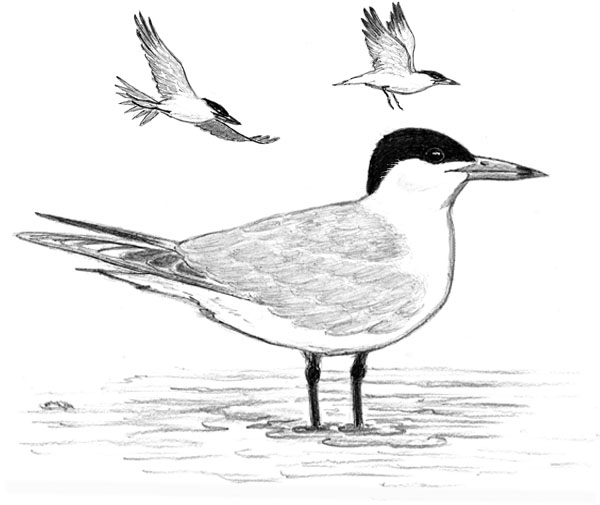
Dear Bird Folks,
Recently, I went on a bird walk with the Virginia Audubon Society. We walked along the James River in an area called the Dutch Gap Conservation Area. On the walk we saw several Caspian Terns. Could you tell me something about these magnificent birds? Also, do they ever migrate up to Cape Cod?
– Elizabeth, Richmond, VA
Tell me, Elizabeth,
I haven’t been to Richmond for a long time, but I’ve been wondering if Virginia is still for lovers? I figured if anyone knew the answer to that question you would. “Virginia is for Lovers” is hands down the best state tourist slogan ever. It’s brilliant. Maine has “The Way Life Should Be.” That’s not too bad, either. Washington State, on the other hand, had the worst one. Their state slogan was (and I’m not kidding) “Say WA!” Yes, you read that right. Say WA! I guess it’s supposed to take advantage of Washington’s postal code, which is WA, but it’s lame. Now if Hawaii had done that, it would have worked. “Say HI!” would be a great slogan. Even Massachusetts could have promoted “Say MA!” That wouldn’t have been too bad, but only around Mother’s Day. Missouri could use “Say MO!” as their slogan, but then they would only attract Three Stooges fans, which isn’t a bad thing. I know it would make me want to visit there.
It seems strange having terns around a city like Richmond, which isn’t really a seaside community. But then again, in spite of what Cape Codders might think, terns aren’t always seaside birds. Many species can be found well inland. Terns eat fish and it doesn’t make much difference to them if the fish live in salt or fresh water. Caspian Terns breed in scattered pockets along the Atlantic from Florida to Newfoundland and inland along the Great Lakes and around lakes in Saskatchewan. They can also be found nesting in large colonies in western states like California, Oregon and in, of all places, Washington. Say WA!
When most people think of terns they probably think of small, buoyant seabirds that fly like delicate white swallows. Caspian Terns don’t fit this racial profile. They are huge terns and look less like swallows and more like furniture movers. In fact, you won’t see a larger tern anywhere in the entire world. It would take five Common Terns or fifteen Least Terns to equal the weight of a single Caspian Tern. And because they are so big they can go wherever they want without being pushed around. These terns are found from the Americas, to Europe and Asia, and all the way to Australia and New Zealand, where they are called “Taranuis.” It seems those crazy Kiwis have a funky name for everything.
You were right when you called this bird “magnificent,“ Elizabeth. Its wings and back have soft grey feathering, which contrast with its bright white neck and belly. It has a solid black head cap that comes down below the eyes, making the bird look as if it has no eyes, which is a bit creepy. But the key field mark for this bird is the beak. The Caspian Tern has a super large, super bright red/orange beak. Its beak is striking and conspicuous, making it look like it’s eating a carrot. And I’m not talking about one of those puny, snack carrots either. I’m talking about a snowman-nose sized carrot. Noted birder Arthur Cleveland Bent called Caspians the “king of all terns.” They rule the colony and will attack any predator. Well, they’ll attack any predator except Bald Eagles. A powerful raptor beak trumps a carrot nose every time.
As I mentioned earlier, Caspian Terns can found all around the world, so you may have guessed that their name originated from the birds that live around the Caspian Sea. Have you ever been to the Caspian Sea? Neither have I, but it sounds like an odd place. In spite of the name “sea,” it is considered to be a lake, the world’s largest lake, covering over four times more area than Lake Superior. The reason why it’s called a sea is because the water has a high salt content, yet it’s a long way from any ocean. It is bordered by southern Russia, northern Iran, and an assortment of “-stans.” The massive lake/sea produces two cash crops. One is oil and oilrigs line much of its coast. The other moneymaker is sturgeon, those ugly fish that produce the even uglier-tasting snack food, caviar. The giant lake also has several other creatures named after it. In addition to the tern, there is the Caspian Gull and the Caspian Seal. Yes, an inland seal. The Caspian Seal is small, cute and totally land-locked. Since the Caspian Sea has no outlets to the ocean, the little seal has no way of ever meeting up with its oceanic cousins unless it can figure out how to walk or hitch a ride on a passing camel.
If you want to see Caspian Terns, Elizabeth, you are better off looking for them along the coast of the Mid-Atlantic states. Here on Cape Cod we typically only see them for a few short weeks during the spring and fall and even then the birds don’t hang around very long. They are mostly fly-bys, winging their way north or south. Perhaps they would stay around longer if we had a catchy tourist slogan like Virginia has. It’s too bad that “is for lovers” is already taken. Okay. How about this? “Come to Cape Cod: Our Seals Don’t Need to Ride on Camels.” Yes? No? Too long? I’ll work on it and get back to you.